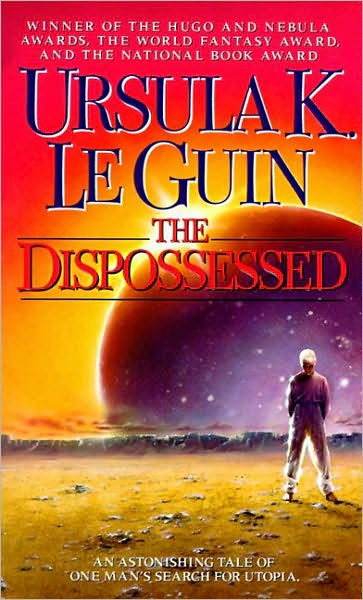
|
| Cover art by Danilo Ducak |

Film This!

|
| Cover art by Danilo Ducak |

| THE DISPOSSESSED An Ambiguous Utopia Ursula K. LeGuin New York: HarperCollins, December 1994 |
Rating: 5.0 High |
|||
| ISBN-13 978-0-06-105488-4 | ||||
| ISBN 0-06-105488-7 | 387pp. | SC/GSI | $7.99 | |
Shevek was an anarchist. Raised on the moon Annares, where dissidents had gone from the primary world Urras to set up a society according to the dictates of Odo, he was thoroughly steeped in that socialist culture where men and women were equal, names were assigned by computer, and all shared in the labors needed to keep things running — from tending crops to abstruse research.
Shevek was an idealist. In his breast there burned the need to unite his two worlds in freedom.
Shevek was a brilliant physicist, perhaps the equivalent of Einstein. This gave him entree into the highest levels of Urrasi society. But there were obstacles in the way of his dream, and not always in plain sight...
The two worlds were in sharp contrast: Annares, poor but unified, Urras decadently rich and filled with disputatious nations; Annares dry and meagerly supplied with biota except in the seas, Urras water-filled and blessed by abundant land animals and birds. Also there was distrust, even hatred, between their two populations (though Urrasi were much better at hating.)
In this conflicted environment, Shevek struggles to balance his two endeavors: to achieve a breakthrough in physics, for which he requires establishment support, and to further the growth of Anarres' mode of living on Urras. This last goal necessarily pushes him toward the role of fomenting revolution — and Urras brings to bear all the standard methods to defeat his plans.
The novel stands alone as a vivid and thoughtful examination of social forms. Yet there are parallels with other works I have read. The society of Anarres closely resembles that of Ira Levin's This Perfect Day except that conformity is not enforced by a hidden elite backed up by advanced pharmacology and computer technology. Rather, the people of Annares obey the orders posting them to mercury mines or holum fields, and away from their life partners, because they have been raised in Odo's unselfish creed and because in the harsh conditions of their world survival depends on cooperation.
Shevek achieves his breakthrough in temporal physics. But his dream of social progress comes to an abrupt halt as he narrowly escapes being shot down when speaking at a peaceful demonstration. In the end, thanks to his success in physics and a few remaining friends, he is deported back to Anarres, essentially back to square one. The reader is left wondering if his message will take hold or if social progress will stall, as it did on our own planet after the "countercultural revolution" of the 1960s.1
Like all of Ursula LeGuin's fiction, this is an elegantly written and compelling tale. In addition, its thoughtful treatment of social themes elevates it to the top rank of her work along with The Left Hand of Darkness and of course the Earthsea stories.

 To contact Chris Winter, send email to this address.
To contact Chris Winter, send email to this address.